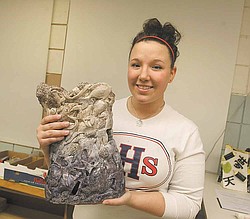Local student wins national art award
The Vindicator (Youngstown)
Fitch High School senior Amber Henik shows off her award-winning ceramics piece “Global Warming Kills More Than Polar Bears.” Her work will be on display in New York City at the World Financial Center’s courtyard gallery through June.
AUSTINTOWN
It took creativity for Fitch High School senior Amber Henik to depict “disintegration of the oceanic environment” in her latest ceramic piece.
“There are really a lot of animals who are in danger,” said Henik, whose family’s scuba-diving excursion in Key Largo years ago had led to an interest in the environment.
Her piece titled “Global Warming Kills More Than Polar Bears” is the winner of a coveted national American Visions Medal through Scholastic’s Alliance for Young Artists & Writers. It’s just one of six pieces Henik has won awards for in this year’s competition.
“I was surprised because I’m very humble,” the 17-year-old said. “I don’t like to have a big head because I think you lose some talent. You’re bound to trip and fall.”
Henik has yet to trip and fall while carrying the piece, though the thought of breaking something so fragile has crossed ceramics teacher Karen Weinberg’s mind more than once.
Weinberg said the work will be shipped through the McDonough Museum at Youngstown State University, which hosts the regional level of the competition and has experience in shipping art, to New York City where it will be on display at the World Financial Center’s courtyard gallery through June.
A scuba vase Henik sculpted and painted in bright colors and completed with a life-size pair of clay goggles won a silver-key award at the same regional competition last year.
Though that piece is Weinberg’s favorite, she wanted Henik’s latest piece to have more depth.
“I told her she needed to push the envelope and make something more sophisticated with a message,” Weinberg said.
The result was a piece that focuses on the plight of fish in the scheme of global warming.
The piece resembles a vase, hollow in the middle but not intended for use. Henik began by shaping the vessel then layering on clay cutouts of tropical fish, sting rays and eels — more than 40 of them — in various stages of decay. She created each fish over the course of a month, building up their bellies and fins with clay and imprinting each scale.
“She has a natural affinity for the clay and an innate ability for how to manipulate it,” Weinberg said. “She knows what it will do and what it won’t do. She can push it to its limits.”
The fish at the bottom were painted with cobalt oxide, a shiny chemical element, resulting in a deep blue color. They are whole and alive at the base but begin to fall apart as they move up the sides, finally turning to mere skeletons, which Henik painted with a lighter brownish oxide.
She used real coral pieces to imprint pieces of live and dead coral that peek between fish. The bubbles left behind when she sponged on areas of oxide popped in the kiln when the piece was fired resulting in what she called an unexpected but appropriate aquatic effect.
When she was finished with the fish and coral, Henik and Weinberg decided negative space would add interest. So Henik cut through sections of clay between fish to add holes. She carved the mouth of the vase so the smooth surface blended better with the many textures on the outside.
“You have to think of it from every angle. It has to look finished,” Henik said.
Art teacher Patti Prentiss has had Henik in class since she was a freshman and said she had to convince her of her talent over the years.
“She started out kind of tentative,” Prentiss said. “I don’t think she really knew she could do art.”
That changed when Akron Children’s Hospital in Boardman purchased one of her colored-pencil drawings inspired by Dale Chihuly, a modern glass artist, at the end of her freshman year.
Henik hopes to major in ceramics or art education at either Ohio University or Kent State University in the fall.
Her winning piece will belong to Scholastic for the next two years and be used in different traveling and temporary exhibits.
“I just had a good feeling about it,” Henik said of her work.
 43
43

